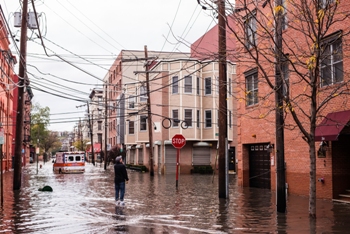Apr 29 2013
U.S. economic losses from extreme weather could at least double by 2050, according to an Oak Ridge National Laboratory analysis published this month in the online edition of the journal Global Environmental Change.
 Research in impacts, adaptation, and vulnerability science has the potential to improve preparation for extreme weather events like Superstorm Sandy, which cost dozens of lives and billions of dollars in damages. Image credit: iStockphoto
Research in impacts, adaptation, and vulnerability science has the potential to improve preparation for extreme weather events like Superstorm Sandy, which cost dozens of lives and billions of dollars in damages. Image credit: iStockphoto
"A side effect of America's growth has been the tendency to put more people, infrastructure and assets in harm's way, and when a storm comes through, that increased exposure drives up economic losses," said author Benjamin Preston, deputy director of ORNL's Climate Change Science Institute, who studied historical data from more than 3,000 U.S. counties and used predictive modeling in the assessment. Preston works in impacts, adaptation, and vulnerability science, a field devoted to analyzing the effects of climate change on people, governments and industries.
So far in the twenty-first century, Americans have seen hefty price tags for extreme weather damage. The bulk of disaster losses are associated with extreme events in highly populated, wealthy areas. In 2011 alone the U.S. witnessed a record 14 weather disasters causing $1 billion or more in damages each. Climate change will likely cause such disasters to occur with greater frequency and severity, as projected in a 2012 Special Report from the Intergovernmental Panel on Climate Change.
Preston sought to quantify what population growth and continued development might mean for future losses, independent of any changes in the frequency or intensity of severe weather events associated with climate change. He used county data about population and wealth from 1960 to 2009 to plot each county's socioeconomic exposure through time. Then he used the historical data to generate predictions of exposure until 2054.
Counties in the Southeast and Southwest could experience the most rapid growth in wealth and exposure, he found, while those in the already densely populated Northeast and West Coast will become exposed to risk more slowly.
Preston projected that current annual U.S. disaster losses of $10 billion to $13 billion could increase by a factor of 1.8 to 3.9 by 2050. Whether losses double or quadruple depends on two different assumptions researchers make when projecting losses based on socioeconomic exposure.
"A commonly used assumption is that losses increase in direct proportion with exposure," Preston said. "So, if a community grows to be twice as wealthy, it will lose twice as much when disaster strikes."
Based on this traditional assumption Preston calculated that future losses would grow slightly faster than the economy as a whole, quadrupling by the year 2050. In a second approach, Preston based his calculations on losses reported in recent Federal Emergency Management Agency disaster assistance applications. This empirical approach suggested losses will grow more slowly than the economy, only doubling by 2050—a difference of billions of dollars compared to loss projections under the traditional assumption. According to Preston, this result suggests that communities may become more resilient to extreme weather as they develop.
Regardless of differences between the two approaches, Preston underscores that losses from extreme events are increasing across the U.S., even without accounting for the potential effects of climate change.
"Despite uncertainties in projecting economic losses of extreme weather events, this study reflects how the U.S. continues to grow more vulnerable to extreme events," Preston said.
Improving projections for population growth and development, as well as changes in climate, could inform social and political debate over whether individual communities should invest in changes now to protect their people and property in the future.
UT-Battelle manages ORNL for DOE's Office of Science. The Office of Science is the single largest supporter of basic research in the physical sciences in the United States and is working to address some of the most pressing challenges of our time. For more information, please visit http://science.energy.gov/.
The study was funded by ORNL's Laboratory Directed Research and Development program, which supports strategic investments in promising research areas.— Katie Elyce Freeman, April 26, 2013